Frank Sinatra recorded “There Used to Be a Ballpark” in 1973. If this does not rank among classics like “My Way,” “Strangers in the Night” and “New York, New York,” it was still a good one. The song captured how a community had lost its baseball team (generally thought to be the Brooklyn Dodgers or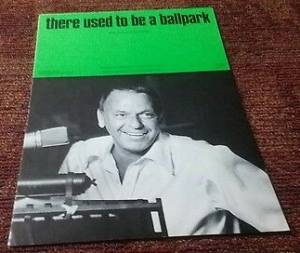 New York Giants) and the stadium (Ebbets Field or the Polo Grounds) where so many games had been played. I can relate, to some degree, as I have sentimental feelings about the Dallas Rangers and Burnett Field on the south side of the Trinity River.
New York Giants) and the stadium (Ebbets Field or the Polo Grounds) where so many games had been played. I can relate, to some degree, as I have sentimental feelings about the Dallas Rangers and Burnett Field on the south side of the Trinity River.
Football, basketball and hockey—North America’s three other main pro sports—can also stir people’s emotions. I know least about hockey, but that is the one I will address here. The Montreal Forum (home to the Montreal Canadiens from 1926 to 1996), Madison Square Garden III (New York Rangers, 1925–1968), Chicago Stadium (Chicago Blackhawks, 1929–1994), Boston Garden (Boston Bruins, 1928–1995) and Olympia Stadium (Detroit Red Wings, 1927–1979) have all been razed. Maple Leaf Gardens, 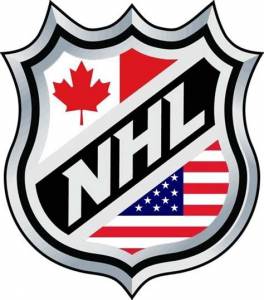 home of the Toronto Maple Leafs from 1931 to 1999, still stands but it has been reconstituted for other purposes. These were truly hockey cathedrals, and fans of the Canadiens, Rangers, Blackhawks, Bruins, Red Wings and Maple Leafs—still the core of a much-expanded NHL—remember them fondly. All have been the subject of books and documentaries.
home of the Toronto Maple Leafs from 1931 to 1999, still stands but it has been reconstituted for other purposes. These were truly hockey cathedrals, and fans of the Canadiens, Rangers, Blackhawks, Bruins, Red Wings and Maple Leafs—still the core of a much-expanded NHL—remember them fondly. All have been the subject of books and documentaries.
While I lack any strong connection to Montreal (in fact, I have never been there), New York, Chicago, Boston and Toronto, that is not the case for Detroit. I lived in a suburb of the so-called Motor City in the early 1970s and witnessed games featuring the Pistons, Tigers and Lions. I saw basketball at Cobo Arena, and baseball and football at Tiger Stadium. I regret not having attended a Red Wings game at Olympia Stadium, although I watched the puck drop when they played the Dallas Stars at American Airlines Center in 2007.
The history of the “old red barn” may be summarized as follows. Detroit was booming in the 1920s, thanks in large part to the automobile industry. Its NHL franchise, then known as the Cougars, needed a home. Howard C. Crane was hired, and he designed a handsome and 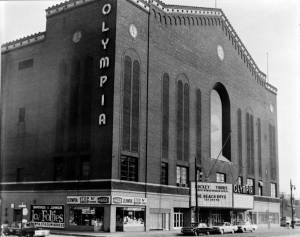 imposing facility with a Romanesque exterior. There was seating for 11,500 fans (expanded by 3,000 in 1966), and sight lines and acoustics were superb. I mention that last point because Olympia Stadium was always more than a hockey rink. It cost $2.5 million and was a landmark at the intersection of Grand River Avenue and McGraw Street in the northwest part of the city.
imposing facility with a Romanesque exterior. There was seating for 11,500 fans (expanded by 3,000 in 1966), and sight lines and acoustics were superb. I mention that last point because Olympia Stadium was always more than a hockey rink. It cost $2.5 million and was a landmark at the intersection of Grand River Avenue and McGraw Street in the northwest part of the city.
The first game, on November 22, 1927, was a 2-1 loss to the Ottawa Senators. The University of Michigan marching band was there, having opened up the Wolverines’ new football stadium in Ann Arbor five days earlier against Ohio State. After expressing amazement at the speed and power of big-time hockey, a Detroit News writer opined, “Detroit now has a place for public events that ranks among the best in the world, well-equipped for boxing shows, pageants, conventions and theatrical spectacles.”
Coach and general manager Jack Adams kept the team alive in the Depression and got to the top of the heap in 1936 by winning the Stanley Cup. The mid-1930s was a good time for sports fans in the city, as the Tigers won the World Series in 1935 and the Lions became 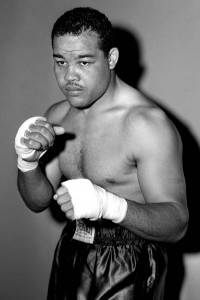 NFL champs that same year. Joe Louis, born in Alabama but an adoptee of Detroit, became the heavyweight champion in 1937 and held that title for 11 years. Louis fought at Olympia Stadium several times. So would Thomas Hearns, the holder of world titles in five weight divisions.
NFL champs that same year. Joe Louis, born in Alabama but an adoptee of Detroit, became the heavyweight champion in 1937 and held that title for 11 years. Louis fought at Olympia Stadium several times. So would Thomas Hearns, the holder of world titles in five weight divisions.
Detroit liked to call itself “hockeytown, USA” and for good reason. The Wings also won titles in 1937, 1943, 1950, 1952, 1954 and 1955 before starting a long dry spell. Of all the players I could mention, one stands above the rest: Gordie Howe of Floral, Saskatchewan. There is no disagreement among hockey historians that Howe was one of the best players of all time. He wore the red-and-white “winged wheel” uniform from 1947 until 1971.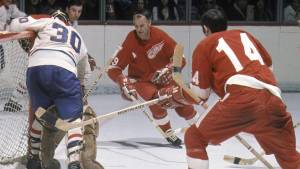
There was another tenant at Olympia Stadium during this time, the basketball-playing Pistons. Fred Zollner had moved them to Detroit from Fort Wayne, Indiana in 1957. They stayed for five seasons until Cobo Arena opened.
While I would rather not, I must touch on an unpleasant fact about this city, once known as the Paris of southeastern Michigan. Massive numbers of blacks had come up from the South (Louis, for example) in the 1920s. That eventually led to racial unrest as Whites were not always welcoming. Detroit was the scene of major race riots in 1943 and 1967, and it has never fully recovered. Fundamental changes in the auto industry were a part of that process. The city’s population peaked at 1.8 million in 1950 and is now barely 600,000.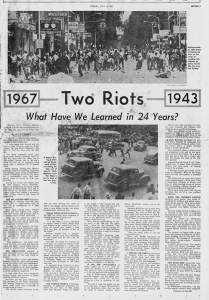
Olympia Stadium was solid but outdated, and the neighborhood in which it sat could only be called “explosive.” Getting in and out safely was becoming harder. The Lions had moved to the suburbs, and Red Wings owners were tempted to follow suit. But the city was willing to build a replacement on the riverfront and made a sweet offer. The decision was made, and the team would go. On December 15, 1979, the Wings and Quebec Nordiques battled to a 4-4 tie. For the next 38 years, they made Joe Louis Arena home. (Please allow me to pause and say that it was absurd to name a hockey facility for a boxer. This was done because of racial politics, pure and simple.)
How sad it was to have Olympia Stadium empty, forlorn and deteriorating for seven years! It certainly could have been altered and had a second life; recall what happened to Maple Leaf Gardens in Toronto. But that would have required imagination and flexibility on the part of Detroit’s civic and business leaders. When the time came for this building to be razed, it would have to be done slowly—almost brick 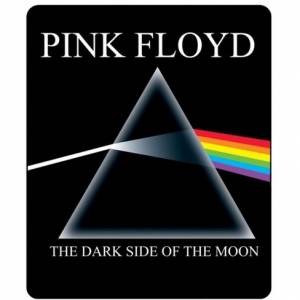 by brick. More modern sports arenas can fall quickly and easily (Texas Stadium in 2010 comes to mind) with a series of explosive charges. Tiger Stadium suffered the same fate as Olympia Stadium, closing in 1999 and not being demolished until 2009.
by brick. More modern sports arenas can fall quickly and easily (Texas Stadium in 2010 comes to mind) with a series of explosive charges. Tiger Stadium suffered the same fate as Olympia Stadium, closing in 1999 and not being demolished until 2009.
Finally, my connection to this storied edifice. I was there twice, to enjoy rock concerts. On June 23, 1973, my brother and I entered Olympia Stadium to see Pink Floyd, whose classic album “Dark Side of the Moon” had just been released. And on October 21, 1974, I attended a Traffic concert with my girlfriend, Pam Grover. We were going through an excruciatingly painful breakup. She was in a world of hurt and paid no mind when the band played songs such as “Who Knows What Tomorrow May Bring” and “John Barleycorn” (fifth and ninth, respectively, on the setlist). Time and again, Pam kissed the side of my face, looked deep into my eyes and said, “I love you.”

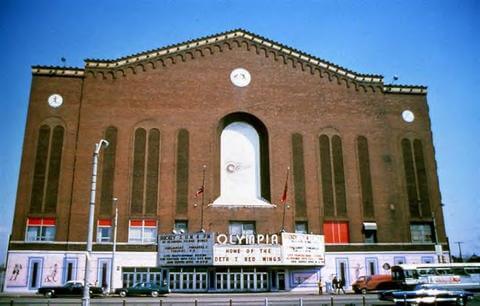
12 Comments
Richard, I really liked your story about the stadiums of days past! Very nostalgic! Here we have built a new enclosed stadium for the Texas Rangers Major League team called Globe Life Field. The 20 year old Globe Life Park has been toured into a soccer stadium. So, we have three major sports stadiums just a quarter mile from one another. If the Summer Olympics need a place to play, Arlington should be at the top of their list. Then we have American Airlines Arena in Downtown Dallas where the NBA Mavericks and NHL Stars play. We have the whole package right here in the D/FW Metroplex. None of them are old either.
Thank you, Andy. It’s interesting how those three stadium are so close together, even though one is “just” for soccer. I show my bias by not regarding that as a major pro sport. One fact I left out of my story is that the Pistons and Red Wings now play at Little Caesar’s Arena. It is quite close to Ford Field (Lions) and Comerica Park (Tigers).
Nice article, though the lingering sentiment and description of your pending breakup is what I most remember as I am typing this…not that the subject and context of your post is dismissed…in fact, I have never heard (or heard of) the Frank Sinatra song…would like to hear it.
Thanks, Bettye. To leave out the part about me and Pammy at the Traffic concert would have been impossible.
Good article, I hate losing the old stadiums. Glad Fenway and the Cotton Bowl still exist. We were there for the implosion of Texas Stadium across in a parking lot on the southside and I still remember the sadness I felt as the charges pounded it down. Jerry and his group were on the westside where the wind carried all the dust, must have been nasty for them. It seemed justified given “America’s team” played there and we all knew the real reason for the hole in the roof.
Kenny–yes, the Cotton Bowl is still standing, but I cannot see how it is viable since the only major event there is UT-Oklahoma every October. How about Wrigley Field?
They do a holiday game there too, but that’s about it. Jerry’s stadium gets most of the activity including the holiday Cotton Bowl. I think it has been used for soccer too. Hard to justify the maintenance I would think, but Dallas city council has been a joke for a long time.
This is not about the Cotton Bowl. I wrote about it here–https://richardpennington.com/2018/06/brooding-about-the-cotton-bowl/
What an interesting review of stadiums being razed in the name of progress. Progress will justify tearing down these landmarks in the USA, while in Europe, landmarks stay for centuries. I see both points of view, but when it comes down to comfort, I’ll take an air conditioned stadiums for football and baseball over stadiums like the Cotton Bowl. You also made me think of watching the Ice Capades and Ice Hockey at the Fair Park in the Livestock Coliseum. Here is another one. What about 22,000 seat Cobb Stadium, home of the Dallas Tornado, demo’d in 1985? I think I watched a football game there once as a kid. Did you ever go there? There was also a venue for concerts, bowling and sporting events off I30 in Oak Cliff called Bronco Bowl, demolished in 2003. It headlined some bands that became pretty famous, David Bowie, Bruce Springsteen, U2. Sounds like a “rock’n” place to go, but I never went, how about you?
Comfort is one issue, and Olympia was lacking in that regard. Still, they could have found a way to preserve it.
I have enjoyed reading your article and everyone’s comments. It is amazing how many sporting venues have come and gone just in our life time. So much history comes tumbling down in an instant! The new Globe Life Field will be hosting the World Series this year!
“Pam kissed the side of my face, looked deep into my eyes and said, “I love you.”
This is what i can fondly remember, i see this as romantic and cute!! Sorry, I cannot relate with the stadiums being demolished!
Nice article Rich!
Add Comment